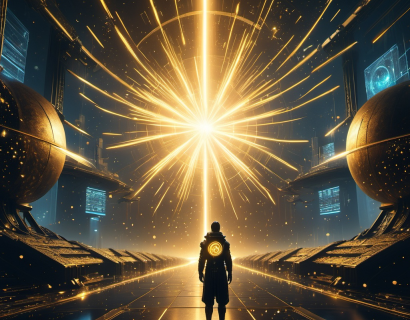Decentralized Innovation Meets AI: Unlocking Next-Gen Digital Transformation with Crypto-Powered Solutions
The intersection of decentralized technology and artificial intelligence (AI) is giving birth to a new era of digital transformation. This convergence is not just a technological curiosity but a powerful force reshaping industries and redefining how we interact with digital solutions. For tech enthusiasts and early adopters, understanding this synergy is crucial as it opens up a world of possibilities for innovation and efficiency. This article delves into the transformative impact of decentralized applications and services powered by AI and cryptocurrency, exploring how these technologies are merging to create a more secure, transparent, and user-centric digital landscape.
Understanding Decentralized Applications
Decentralized applications, or dApps, are software applications that run on a blockchain or a decentralized network rather than on a central server. This design eliminates single points of failure and reduces the risk of censorship or manipulation. Unlike traditional applications, dApps are transparent, meaning all transactions and data are visible on the blockchain, ensuring accountability and trust. The decentralized nature also means that dApps are less vulnerable to hacks and data breaches, as there is no central authority to target.
The architecture of a typical dApp includes a front-end user interface, a back-end smart contract, and a decentralized network. The smart contract, written in a programming language like Solidity, automates and enforces the rules of the application, ensuring that all participants adhere to the predefined protocols. This automation reduces the need for intermediaries, lowering costs and increasing efficiency.
AI in Decentralized Systems
Integrating AI into decentralized systems amplifies their capabilities, enabling more intelligent, adaptive, and autonomous applications. AI can process vast amounts of data, identify patterns, and make predictions, all of which are invaluable in a decentralized environment where data is distributed and often unstructured. For instance, AI algorithms can enhance the functionality of decentralized finance (DeFi) platforms by providing sophisticated risk assessment tools, automated trading bots, and personalized financial advice.
One of the key benefits of combining AI with decentralized systems is the enhancement of data utility. In a decentralized network, data is fragmented across multiple nodes, making it challenging to derive actionable insights. AI can aggregate and analyze this data, transforming it into meaningful information that can drive decision-making processes. This is particularly useful in decentralized identity management, where AI can help verify and authenticate user identities securely and efficiently.
Cryptocurrency as a Catalyst
Cryptocurrency plays a pivotal role in this ecosystem by serving as the medium of exchange and a store of value. The decentralized nature of cryptocurrencies aligns perfectly with the principles of dApps, ensuring that transactions are secure, transparent, and tamper-proof. Blockchain technology, the backbone of cryptocurrencies, provides a immutable ledger that records all transactions, enhancing trust and reducing the need for intermediaries.
Moreover, cryptocurrencies enable decentralized governance models through token-based systems. Token holders can participate in decision-making processes, voting on proposals and upgrades. This democratization of governance ensures that the development of dApps and decentralized services is community-driven, fostering innovation and inclusivity. For example, decentralized autonomous organizations (DAOs) leverage blockchain and token economics to manage projects and funds collectively, without the need for traditional hierarchical structures.
Use Cases of Decentralized AI Applications
The potential applications of decentralized AI are vast and varied, spanning multiple industries. Here are some notable use cases that highlight the transformative impact of this convergence:
- Decentralized Finance (DeFi): AI-driven DeFi platforms can offer advanced trading strategies, automated portfolio management, and enhanced credit scoring. These platforms can operate 24/7, providing access to financial services for underserved populations and reducing transaction costs.
- Supply Chain Management: AI can optimize supply chain operations by predicting demand, detecting fraud, and ensuring compliance with regulations. Decentralized supply chain solutions can improve transparency and traceability, reducing delays and enhancing trust among stakeholders.
- Healthcare: Decentralized health platforms can use AI to analyze medical data, assist in diagnosis, and manage patient records securely. These platforms can facilitate remote consultations and personalized treatment plans, making healthcare more accessible and efficient.
- Content Creation and Distribution: AI-powered content generation and curation can revolutionize the media industry. Decentralized platforms can reward creators fairly through tokenization, ensuring that content producers receive compensation for their work. AI can also help in filtering misinformation and personalizing content for users.
- Internet of Things (IoT): In the IoT ecosystem, decentralized AI can manage and analyze data from numerous connected devices, optimizing resource usage and enhancing security. Smart contracts can automate interactions between devices, reducing the need for centralized control and increasing efficiency.
Challenges and Considerations
While the potential of decentralized AI applications is immense, there are several challenges and considerations that need to be addressed:
First, scalability remains a significant issue. Blockchain networks, especially those using proof-of-work consensus mechanisms, can struggle with high transaction volumes and slow processing times. Layer 2 solutions and alternative consensus mechanisms like proof-of-stake are being developed to address these bottlenecks.
Second, regulatory uncertainty poses a risk. The decentralized and borderless nature of blockchain and cryptocurrency transactions complicates compliance with existing laws and regulations. As the technology matures, it is essential to work with regulatory bodies to create a clear and supportive framework.
Third, user adoption is crucial. Educating users about the benefits and functionalities of decentralized AI applications is necessary to drive widespread adoption. User-friendly interfaces and intuitive onboarding processes can help bridge the knowledge gap.
Future Outlook
The future of decentralized AI applications is promising, with ongoing advancements in blockchain technology, AI algorithms, and infrastructure. As the ecosystem grows, we can expect to see more sophisticated and integrated solutions that leverage the strengths of both decentralization and AI. The synergy between these technologies has the potential to drive significant innovation, making digital transformation more accessible, secure, and beneficial for all.
For tech enthusiasts and early adopters, embracing this convergence is not just a t



